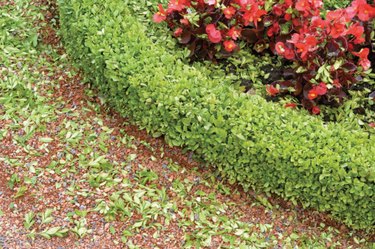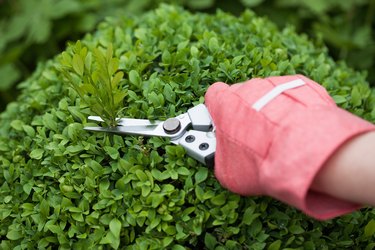Things You'll Need
Pruning shears
Garden shovel

The boxwood (Buxus sempervirens) is a popular ornamental shrub. Ranging in height from 2 to 15 feet, it is commonly used for hedges, edgings and in topiaries as its dense growth can be easily trimmed into a number of shapes. While the boxwood is hardy and easy to grow, however, it is possible for it to become ill. Diseased, dead or damaged shrubs need to be replaced. Even if they are not ill, shrubs occasionally outgrow their intended purpose or sometimes homeowners simply want to update their landscape. Under these circumstances, action to remove the boxwood shrub may be necessary.
Planning to Remove the Plant
Determine what you would like to do with your boxwood once it has been removed from its present location. If you are transplanting the shrub to another part of the yard, prepare the new planting site before the start of the removal process. Additionally, if you are moving the shrub rather than discarding it, care will have to be taken during the removal process to avoid causing unnecessary damage to the roots.
Video of the Day
Video of the Day
Prepare the Boxwood
Water the shrub thoroughly to a depth of about eight inches as this will soften the ground and make the digging less difficult. A good watering also reduces the likelihood that the root ball may break apart and drop from the boxwood's roots as you remove the plant. Watering the shrub well also lessens the transplant shock that may result from moving it.

Prune the shrub to make the plant easier to handle. If you are discarding the plant, simply cut away any unwanted branches with sharp pruning shears. If you are transplanting the shrub, remove any dead branches and trim back any overgrown sections by holding the clippers at a 45 degree angle and cutting the undesirable growth away.
Breaking Ground for Removal
Break up soil around the plant. Place a garden shovel approximately 2 feet from the base of the boxwood and dig straight down. Gradually work your way around the boxwood, creating a trench that surrounds the shrub. Remove as much soil from the base of the plant as possible, exposing the root ball. If you are transplanting the shrub, take care not to cut through the roots as this will impair the plant's ability to take in water, hindering its growth.
Loosen the Shrub
Slide the edge of the shovel beneath the uncovered roots at the outer edges of the root ball. Wiggle the shovel slightly, knocking any residual soil loose and freeing the roots from the earth. Work your way toward the center of the plant, releasing roots as you remove the plant.
Lift the Boxwood From the Soil

Grab the shrub firmly at the base and rock it gently until the boxwood moves freely and easily in the soil. Then carefully lift it from its planting site to completely remove the shrub. Brush away any large clumps of soil that are clinging to the roots. If you are transplanting the shrub, water the exposed roots and then immediately move the boxwood to its new planting site.